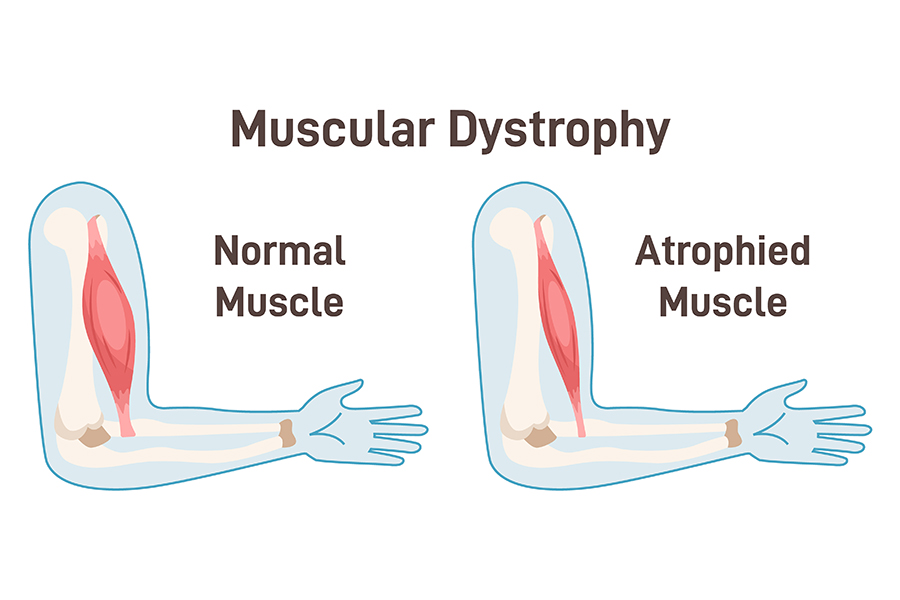NCATS Enables a Drug’s Path to FDA Approval for Duchenne Muscular Dystrophy
March 15, 2024
In late 2023, the investigational drug vamorolone received approval from both the U.S. Food and Drug Administration and the European Medicines Agency to treat children and adults with Duchenne muscular dystrophy (DMD). It became the first DMD therapy approved by both agencies.
DMD is a rare, inherited, often devastating disease that weakens muscles. More than a decade ago, a Rockville, MD-based company, ReveraGen BioPharma Inc., approached NCATS’ Therapeutics for Rare and Neglected Diseases (TRND) program with a compound it hoped to develop into a drug. The compound, VBP15, is a type of dissociative anti-inflammatory steroid (corticosteroid). It showed promise for treating the disorder while also reducing some of the side effects linked to corticosteroid use. A dissociative drug can provide a health benefit without side effects.
DMD is caused by the loss of dystrophin protein in muscle tissues. It leads to progressive difficulties with walking and daily activities. DMD primarily affects young boys, who often develop heart and breathing complications.
Corticosteroids are a type of steroid hormone drug. Such drugs are widely used and effective in treating DMD and many other inflammatory disorders. But long-term use comes with life-changing side effects. These can include stunted growth, easily broken bones, mood disturbances, and weight gain. Researchers sought to develop an effective steroid drug without the accompanying downsides.
ReveraGen CEO and co-founder Eric Hoffman, Ph.D., and his colleagues built a DMD research team at Children’s National Hospital in Washington, D.C., over two decades ago. They wanted to better understand how steroids were effective in treating DMD symptoms. Working with chemist John McCall, Ph.D., they designed a series of non-hormone steroids that they thought would stabilize muscle cell membranes. They hoped such steroids would counteract the lack of dystrophin protein in the muscles of those with DMD.
“A steroid hormone works by binding to a receptor inside the cell,” said Hoffman, now also professor of pharmaceutical sciences at Binghamton University in New York. “The steroid-receptor complex then interacts with key genes to reduce inflammation. We found our drugs did that but also worked quite differently from other anti-inflammatory steroids.”
“We found that the dissociative steroid compounds could bind to the same receptor in a muscle cell and reduce inflammation in mouse models of DMD,” said ReveraGen co-founder Kanneboyina Nagaraju, Ph.D., at Binghamton University. The compounds did not stunt growth or affect the bones like prednisone, a standard DMD steroid drug.
To further develop one of the compounds, ReveraGen reached out to TRND for its expertise and resources. This included its de-risking ability to move the drug’s preclinical development forward.
“They had a non-hormonal, steroidal, anti-inflammatory investigational drug that they thought could be better than the standard of care steroid treatment that comes with many side effects,” explained Liz Ottinger, Ph.D., Acting Director of the NCATS Therapeutic Development Branch. “It seemed like an ideal candidate for TRND to take on. Our initial goal was to help make vamorolone a viable commercial product for DMD. We were also intrigued by the possibility that the dissociated properties of vamorolone might make it applicable to other inflammatory conditions typically treated by traditional steroids.”
TRND scientists completed the necessary studies to show vamorolone was effective against DMD in cells in the laboratory dish and in animal models. They developed a method to make quantities of vamorolone by large-scale manufacturing. They also improved the manufacturing system so vamorolone could be cost-efficient to produce.
“The drug’s development wouldn’t have been possible without NCATS’ help,” Hoffman said. “They brought the drug manufacturing and non-clinical expertise we needed to advance the project. They developed a drug synthesis method and performed necessary toxicology studies and drug design work. They also de-risked our program by validating key assays we had already done. This allowed us to continue to meet important milestones in the drug’s development.”
The TRND team participated in a pre-Investigational New Drug (IND) meeting with the FDA. Both groups discussed what remained to be done in the drug’s development. With support from TRND, researchers were able to generate the data package necessary for filing an IND application for VBP15. An IND is necessary for clinical testing in patients.
As TRND’s work was wrapping up, ReveraGen secured additional funding from the Muscular Dystrophy Association and other non-profit organizations as part of a public-private partnership to continue the development of vamorolone. This also included support from a small business grant from the National Institute of Neurological Disorders and Stroke and a Horizons 2020 grant from the European Commission. Both grants enabled ReveraGen to conduct clinical trials to test the investigational drug’s safety and effectiveness. The results from a key trial ultimately led to vamorolone’s approval by the FDA.
ReveraGen currently is testing vamorolone, now marketed as Agamree, as a treatment for another related disorder, Becker muscular dystrophy.
NCATS’ involvement “both facilitated and de-risked our program,” Hoffman said. “Its ‘stamp’ enabled us to secure other funding from foundations and federal agencies and helped make vamorolone’s success possible.”



